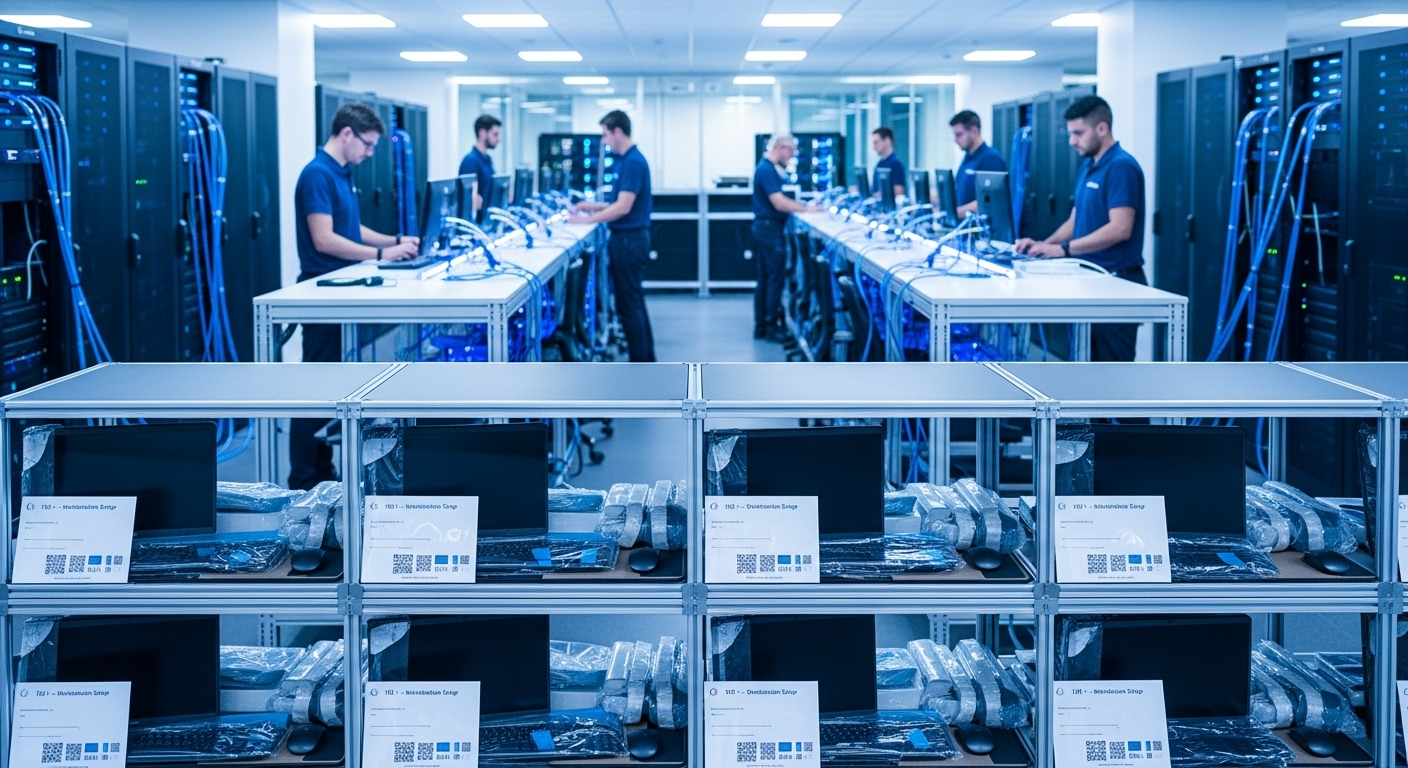In the complex choreography of setting up a new office or upgrading an existing one, IT deployment is often seen as the final, frantic step. Boxes of hardware arrive, technicians scramble, and the goal is simply to get the lights blinking before the doors open. This reactive approach, however, is a recipe for budget overruns, security vulnerabilities, and costly downtime. The modern workplace demands a paradigm shift: treating IT setup not as a technical task, but as a strategic logistical operation. A truly resilient digital backbone isn’t just about the technology you choose; it’s about how you source it, stage it, and seamlessly integrate it into your physical space. This unified strategy, which bridges the gap between the procurement order and the fully functional network, is the key to building a technological foundation that is secure, scalable, and ready for the future. This article outlines a comprehensive framework for mastering IT procurement and deployment logistics, moving your organization from chaotic installations to a streamlined, strategic rollout.
The Strategic Sourcing Framework: Beyond the Lowest Bidder
The foundation of a robust IT infrastructure is laid long before the first server is unboxed. It begins with strategic sourcing—a process that transcends the simple pursuit of the lowest price. While budget is a critical constraint, a procurement strategy focused solely on initial cost often leads to higher Total Cost of Ownership (TCO) through increased maintenance, poor support, and compatibility issues. A forward-thinking framework evaluates vendors and hardware on a broader set of criteria. Scalability is paramount; the equipment you buy today must support your growth for the next three to five years. This means assessing not just the raw performance of a server or switch, but its capacity for expansion, the ease of adding licenses, and its compatibility with future technologies. Another critical factor is the vendor’s support ecosystem. When a critical piece of hardware fails, the speed and quality of support can be the difference between a minor hiccup and a full-blown crisis. Evaluate service-level agreements (SLAs), the availability of local technicians, and the vendor’s track record. Building strong relationships with a few key partners often yields better results than chasing one-off deals. These partners can offer valuable insights into product roadmaps, provide demo units for testing, and help navigate complex supply chain logistics, which have become increasingly volatile. As one CIO recently noted,
“Our most valuable vendors are the ones who act like an extension of our own team. They understand our business goals and help us build a technology stack that achieves them, rather than just selling us the latest product.”
By shifting the focus from price to partnership, scalability, and support, you build an infrastructure that is not only cost-effective over its lifecycle but also resilient and aligned with your long-term business objectives.
Staging and Configuration: The Off-Site Advantage
One of the most disruptive phases of any IT deployment is the on-site setup. Desks are cluttered with packaging, technicians are competing for space, and the pressure to get everything working against a tight deadline is immense. A highly effective strategy to mitigate this chaos is off-site staging and configuration. This involves having all new hardware—laptops, servers, switches, firewalls, and access points—delivered to a controlled environment, such as a vendor’s facility or a dedicated staging area, rather than directly to the office. In this environment, technicians can work efficiently without disrupting daily operations. Here, they can perform crucial setup tasks that are difficult to manage in a live office. This includes asset tagging every piece of equipment for easy tracking in your IT Asset Management (ITAM) system. It’s also the ideal time to create and deploy standardized software images. Instead of manually setting up each laptop, a master image with the correct operating system, security software, and business applications can be pushed to all devices simultaneously, ensuring consistency and saving hundreds of hours. For network and server equipment, technicians can update firmware, pre-configure IP addresses, set security policies, and test hardware functionality. This pre-deployment testing is invaluable; discovering a faulty network card or a dead power supply in the staging area is a minor inconvenience, while discovering it on launch day can derail the entire project. This methodical, off-site preparation transforms the final on-site installation from a complex configuration project into a simpler, faster “rack and stack” and plug-in process, drastically reducing the risk of errors and minimizing the impact on employee productivity.
The Deployment Blueprint: Choreographing the Physical and Digital Rollout
A successful IT deployment is a masterclass in project management, requiring the seamless choreography of digital setup and physical logistics. The Deployment Blueprint is a detailed plan that serves as the single source of truth for all stakeholders, from IT technicians to facilities managers and electricians. This plan must begin with a thorough site survey. You need to know the precise locations for the server room, network closets, wireless access points, and floor ports. This requires close collaboration with the office design and facilities teams to ensure that power requirements, cooling capacity, and physical security are all addressed before any equipment arrives. The blueprint should map out a clear timeline that aligns technology milestones with construction or renovation schedules. For example, the installation of structured cabling must be completed before walls are closed and floors are sealed. The activation of the primary internet circuit (ISP turn-up) should be scheduled weeks in advance and tested thoroughly before the move-in date. A critical component of the blueprint is a detailed rack diagram for the server room, showing the exact position of every server, switch, and power distribution unit. This eliminates guesswork and ensures optimal airflow and cable management. On deployment day, the blueprint acts as a step-by-step guide. The plan should dictate the order of operations: first, install and power up the core network switches and firewalls; second, connect and test internet connectivity; third, bring servers and storage systems online; finally, deploy and connect endpoint devices like laptops and printers. This phased approach allows for systematic testing at each stage, making it easier to isolate and resolve issues as they arise. Without this level of detailed planning, teams are left to improvise, leading to disorganized cabling, improper equipment placement, and a cascade of problems that can delay your office opening.
Integrating the Network Core: From Cabling to Cloud Connectivity
The network core is the central nervous system of your office, and its design determines the speed, reliability, and security of your entire operation. Its integration involves much more than just plugging in a few switches. It starts at the most fundamental layer: structured cabling. Using high-quality Cat6A or fiber optic cabling, properly installed and certified, is a non-negotiable investment. A well-designed cabling plan ensures that every desk, conference room, and wireless access point has a reliable, high-speed connection back to the network closet. The physical layout is equally important. Wireless access points must be strategically placed to provide complete coverage without creating channel interference, a task that often requires a professional Wi-Fi heat map survey. Once the physical layer is in place, the focus shifts to the logical configuration. This is where you architect the flow of data. Implementing Virtual LANs (VLANs) is essential for segmenting network traffic. For example, you can create separate VLANs for corporate users, guest Wi-Fi, and sensitive systems like finance, preventing a security breach in one area from spreading to others. A critical aspect of modern network design is the integration with cloud services. Your office network is no longer an isolated island; it’s a gateway to critical SaaS applications and cloud infrastructure. This requires a robust, business-grade firewall to manage traffic and a reliable, redundant internet connection. Many businesses now opt for a Software-Defined WAN (SD-WAN) solution, which can intelligently route traffic over multiple internet connections (e.g., fiber and 5G) to ensure uptime and optimize performance for cloud applications. This ensures that a single ISP outage doesn’t bring your entire business to a halt. By meticulously planning both the physical cabling and the logical architecture, you build a network backbone that is not just fast, but also secure, resilient, and ready for the demands of a cloud-centric world.
Layering Security from Day One: A Zero-Trust Approach
In a traditional IT setup, security was often an afterthought—a firewall was installed at the perimeter, and anything inside the network was considered trusted. This outdated model is dangerously inadequate for today’s threats. A modern, secure deployment embeds security into every layer of the infrastructure from the very beginning, built on the principle of “Zero Trust.” This framework assumes that no user or device is inherently trustworthy, whether inside or outside the network. Verification is required for anyone trying to access resources. Implementing a Zero-Trust model begins during the deployment phase. Network Access Control (NAC) is a foundational technology. A NAC solution can identify every device that connects to the network, assess its security posture (e.g., is its antivirus software up to date?), and grant access only to the specific resources it’s authorized to use. A guest’s smartphone, for instance, might only get internet access, while a corporate laptop gets access to company servers. Identity and Access Management (IAM) is another critical layer. Instead of relying on simple passwords, this means deploying multi-factor authentication (MFA) for all users from day one. This ensures that even if a user’s password is stolen, their account remains secure. Endpoint security is equally vital. Every laptop and server should be deployed with advanced endpoint detection and response (EDR) software, which uses AI and behavioral analysis to identify and block sophisticated threats that traditional antivirus software might miss. By integrating these security layers—NAC for the network, IAM for users, and EDR for devices—during the initial setup, you create a deeply embedded security posture that is far more effective than trying to bolt on security products after the fact. This security-first approach is no longer optional; it is an essential part of building a resilient and trustworthy business backbone.
Day Two and Beyond: Lifecycle Management and Asset Tracking
The successful launch of a new IT setup is a milestone, not the finish line. The true test of a strategic deployment is its performance and manageability over the long term. This is where IT Asset Management (ITAM) and lifecycle planning become indispensable. From the moment a device is procured, it should be entered into an ITAM system. This system serves as a comprehensive database for all your technology assets, tracking crucial information such as purchase date, warranty expiration, assigned user, physical location, and maintenance history. The asset tags applied during the off-site staging phase are what make this tracking efficient. A robust ITAM program provides numerous benefits. It simplifies software license compliance, preventing costly audit failures. It allows you to accurately forecast future hardware needs and budget for technology refresh cycles. When a user’s laptop is four years old and its warranty is expiring, your ITAM system should proactively flag it for replacement, ensuring employees have reliable tools and avoiding productivity loss from failing hardware. Lifecycle management also extends to the end of an asset’s useful life. A formal process for decommissioning old equipment is critical for both data security and environmental responsibility. This includes securely wiping all data from hard drives to industry standards before the hardware leaves your premises. It also involves partnering with a certified e-waste recycling vendor who can responsibly dispose of electronic components. As one IT director commented,
“Without a solid ITAM strategy, you’re flying blind. You don’t know what you have, where it is, or when it needs to be replaced. It’s the difference between proactive management and constant firefighting.”
By integrating lifecycle management into your initial deployment strategy, you ensure that your technology backbone remains robust, secure, and cost-effective for years to come.
Ultimately, the journey from a collection of boxes to a cohesive digital backbone is a testament to the power of strategic planning. By moving beyond a reactive, task-based approach to IT setup, organizations can avoid the common pitfalls of last-minute scrambles and unforeseen costs. A unified strategy that meticulously integrates procurement, off-site staging, and coordinated deployment transforms the entire process. It turns a potential source of chaos into a predictable and efficient operation. This holistic view, encompassing everything from vendor selection and cabling blueprints to Zero-Trust security and lifecycle management, builds more than just a functional network. It creates a resilient, secure, and scalable technological foundation that becomes a true business enabler. In an era where digital operations are synonymous with business operations, investing the time to architect this process correctly is not an IT expense; it is a fundamental investment in your organization’s future agility and success. The result is an infrastructure that works seamlessly from day one and is built to evolve with the demands of tomorrow.





